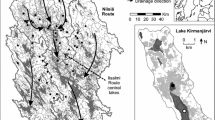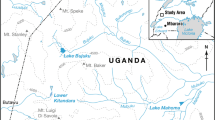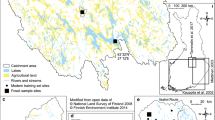Abstract
Intensive agricultural practices can dramatically change the landscape, thereby increasing the concentrations and rates at which nutrients are delivered to aquatic ecosystems. In the United States, concerns about accelerating rates of lake eutrophication related to increases in nutrient loading require a method of quantifying ecological changes that have occurred since European settlement. Because the application of traditional quantitative total phosphorus transfer functions in paleolimnology has proven difficult in shallow, hypereutrophic lakes, we used several approaches in this study to assess ecosystem changes associated with eutrophication of 32 natural lakes in the state of Iowa, USA. In addition to traditional transfer function methods, we estimated changes in primary productivity from the flux of biogenic silica (BSi) and organic carbon accumulation rates (OC AR). Additionally, we compared pre-disturbance diatom communities to modern diatom communities, i.e. floristic change, using non-metric multi-dimensional scaling and square chord distance. OC AR and BSi fluxes increased over time and were positively correlated with the time period of agricultural intensification in the region (post-1940). Ninety-one percent of the lakes in this study showed evidence for eutrophication based on geochemical proxies, and 88 % of lakes showed major floristic change in the diatom community. Whereas geochemical indicators showed consistent increases in productivity across most lakes, floristic changes reflected more complex interactions between other environmental drivers. The magnitude of floristic change did not directly correlate to nutrient-driven increases in primary production, but was driven by ecological diatom assembly related to lake depth. Transfer functions consistently perform poorly, especially for shallow lakes, and other techniques that combine geochemistry and diatom ecology are recommended for reconstructions of eutrophication.





Similar content being viewed by others
References
Akaike H (1974) A new look at the statistical model identification. IEEE Trans Automat Contr 19:716–723
American Public Health Association (1998) Standard methods for the examination of water and wastewater, 20th edn. American Public Health Association, Washington DC 1325 pp
Anderson NJ (1989) A whole-basin diatom accumulation rate for a small eutrophic lake in Northern Ireland and its palaeoecological implications. J Ecol 77:926–946
Anderson MJ (2001) A new method for non-parametric multivariate analysis of variance. Austral Ecol 26:32–46
Anderson NJ, Rippey B (1994) Monitoring lake recovery from point-source eutrophication: the use of diatom-inferred epilimnetic total phosphorus and sediment chemistry. Freshw Biol 32:625–639
Anderson NJ, Rippey B, Stevenson AC (1990) Change to a diatom assemblage in a eutrophic lake following point source nutrient re-direction: a palaeolimnological approach. Freshw Biol 23:205–217
Anderson NJ, Dietz RD, Engstrom DR (2013) Land-use change, not climate, controls organic carbon burial in lakes. Proc Biol Sci 280:20131278
Anderson NJ, Bennion H, Lotter AF (2014) Lake eutrophication and its implications for organic carbon sequestration in Europe. Glob Chang Biol 20:2741–2751
Appleby PG (2001) Chronostratigraphic techniques in recent sediments. In: Last WM, Smol JP (eds) Tracking environmental change using lake sediments: basin analysis, coring, chronological techniques. Springer, Dordrecht, pp 171–203
Arbuckle KE, Downing JA (2001) The influence of watershed land use on lake N: P in a predominantly agricultural landscape. Limnol Oceanogr 46:970–975
Bachmann RW, Hoyer MV, Canfield DE (2013) The extent that natural lakes in the United States of America have been changed by cultural eutrophication. Limnol Oceanogr 58:945–950
Battarbee RW (1986) The eutrophication of Lough Erne inferred from changes in the diatom assemblages of 210Pb and 137Cs-dated sediment cores. Proc R Ir Acad B 86B:141–168
Battarbee RW, Jones VJ, Flower RJ, Cameron NG, Bennion H, Carvalho L, Juggins S (2001) Diatoms. In: Smol JP, Birks H, Last W (eds) Tracking environmental change using lake sediments: terrestrial, algal, and siliceous indicators. Springer, Dordrecht, pp 155–202
Bennion H, Battarbee R (2007) The European Union Water Framework Directive: opportunities for palaeolimnology. J Paleolimnol 38:285–295
Bennion H, Simpson GL (2011) The use of diatom records to establish reference conditions for UK lakes subject to eutrophication. J Paleolimnol 45:469–488
Bennion H, Juggins S, Anderson NJ (1996) Predicting epilimnetic phosphorus concentrations using an improved diatom-based transfer function and its application to lake eutrophication management. Environ Sci Technol 30:2004–2007
Bennion H, Appleby PG, Phillips GL (2001) Reconstructing nutrient histories in the Norfolk Broads, UK: implications for the role of diatom-total phosphorus transfer functions in shallow lake management. J Paleolimnol 26:181–204
Bennion H, Johnes P, Ferrier R, Phillips G, Haworth E (2005) A comparison of diatom phosphorus transfer functions and export coefficient models as tools for reconstructing lake nutrient histories. Freshw Biol 50:1651–1670
Birks HH, Birks HJB (2006) Multi-proxy studies in palaeolimnology. Veg Hist Archaeobot 15:235–251
Borcard D, Legendre P, Drapeau P (1992) Partialling out the spatial component of ecological variation. Ecology 73:1045–1055
Brugam RB (1978) Human disturbance and the historical development of Linsley Pond. Ecology 59:19–36
Burnham KP, Anderson DR (2004) Multimodel inference: understanding AIC and BIC in model selection. Sociol Methods Res 33:261–304
Carney HJ (1982) Algal dynamics and trophic interactions in the recent history of Frains Lake, Michigan. Ecology 63:1814–1826
Carpenter SR, Caraco NF, Correll DL, Howarth RW, Sharpley AN, Smith VH (1998) Nonpoint pollution of surface waters with phosphorus and nitrogen. Ecol Appl 8:559–568
Conley DJ, Schelske CL (2001) Biogenic silica. In: Smol JP, Birks HJB, Last WM (eds) Tracking environmental change using lake sediments: terrestrial, algal, and siliceous indicators. Springer, Dordrecht, pp 281–293
Crumpton WG, Isenhart TM, Mitchell PD (1992) Nitrate and organic N analyses with second-derivative spectroscopy. Limnol Oceanogr 37:907–913
Davidson TA, Jeppesen E (2013) The role of palaeolimnology in assessing eutrophication and its impact on lakes. J Paleolimnol 49:391–410
Dean WE Jr (1974) Determination of carbonate and organic matter in calcareous sediments and sedimentary rocks by loss on ignition: comparison with other methods. J Sediment Petrol 44:242–248
Dodds WK, Bouska WW, Eitzmann JL, Pilger TJ, Pitts KL, Riley AJ, Schloesser JT, Thornbrugh DJ (2009) Eutrophication of U.S. freshwaters: analysis of potential economic damages. Environ Sci Technol 43:12–19
Dong X, Bennion H, Battarbee R, Yang X, Yang H, Liu E (2008) Tracking eutrophication in Taihu Lake using the diatom record: potential and problems. J Paleolimnol 40:413–429
Downing JA, Watson SB, McCauley E (2001) Predicting Cyanobacteria dominance in lakes. Can J Fish Aquat Sci 58:1905–1908
Downing JA, Cole JJ, Middelburg JJ, Striegl RG, Duarte CM, Kortelainen P, Prairie YT, Laube KA (2008) Sediment organic carbon burial in agriculturally eutrophic impoundments over the last century. Global Biogeochem Cycles 22:GB1018
Eakins JD, Morrison RT (1978) A new procedure for the determination of lead-210 in lake and marine sediments. Int J Appl Radiat Isot 29:531–536
Edlund M, Ramstack J (2006) Diatom-Inferred TP in MCWD Lakes. Report submitted to the Minnehaha Creek Watershed District, Deephaven 33 pp
Efron B, Gong G (1983) A leisurely look at the bootstrap, the jackknife, and cross-validation. Am Stat 37:36–48
Egan KJ, Herriges JA, Kling CL, Downing JA (2009) Valuing water quality as a function of water quality measures. Am J Agric Econ 91:106–123
Elser JJ, Bracken MES, Cleland EE, Gruner DS, Harpole WS, Hillebrand H, Ngai JT, Seabloom EW, Shurin JB, Smith JE (2007) Global analysis of nitrogen and phosphorus limitation of primary producers in freshwater, marine and terrestrial ecosystems. Ecol Lett 10:1135–1142
Engstrom DR, Swain EB (1986) The chemistry of lake sediments in time and space. Hydrobiologia 143:37–44
Fritz SC (1990) Twentieth-Century salinity and water-level fluctuations in Devils Lake, North Dakota: test of a diatom-based transfer function. Limnol Oceanogr 35:1771–1781
Fritz SC, Kingston JC, Engstrom DR (1993) Quantitative trophic reconstruction from sedimentary diatom assemblages: a cautionary tale. Freshw Biol 3:1–23
Hall RI, Smol JP (1992) A weighted-averaging regression and calibration model for inferring total phosphorus concentration from diatoms in British Columbia (Canada) lakes. Freshw Biol 27:417–434
Hall R, Smol JP (2010) Diatoms as indicators of lake eutrophication. In: Smol JP, Stoermer EF (eds) The diatoms: applications for the environmental and earth sciences. Cambridge University Press, Cambridge, pp 122–151
Harrison JA, Frings PJ, Beusen AHW, Conley DJ, McCrackin ML (2012) Global importance, patterns, and controls of dissolved silica retention in lakes and reservoirs. Global Biogeochem Cycles 26:GB2037
Heathcote AJ, Downing JA (2012) Impacts of eutrophication on carbon burial in freshwater lakes in an intensively agricultural landscape. Ecosystems 15:60–70
Heathcote AJ, Filstrup CT, Downing J (2013) Watershed sediment losses to lakes accelerating despite agricultural soil conservation efforts. PLoS ONE 8:e53554
Heiskary S, Wilson B (2008) Minnesota’s approach to lake nutrient criteria development. Lake Reserv Manag 24:282–297
Huisman J, Olff H, Fresco LFM (1993) A hierarchical set of models for species response analysis. J Veg Sci 4:37–46
Jansen F, Oksanen J (2013) How to model species responses along ecological gradients: Huisman-Olff-Fresco models revisited. J Veg Sci 24:1108–1117
Jeffrey S, Mantoura R, Wright S (1997) Phytoplankton pigments in oceanography: guidelines to modern methods. Monographs on Oceanographic Methodology 10, UNESCO Publishing, Paris, 661 pp
Jeppesen E, Jensen JP, Søndergaard M, Lauridsen T, Landkildehus F (2000) Trophic structure, species richness and biodiversity in Danish lakes: changes along a phosphorus gradient. Freshw Biol 45:201–218
Jones JR, Bachmann RW (1978) A survey of water transparency in Iowa lakes. Proc Iowa Acad Sci 85:6–9
Juggins S (2005) C2: software for ecological and palaeoecological data analysis and visualisation, version 1.5
Juggins S (2013) Quantitative reconstructions in palaeolimnology: new paradigm or sick science? Quat Sci Rev 64:20–32
Juggins S, Anderson NJ, Ramstack Hobbs JM, Heathcote AJ (2013) Reconstructing epilimnetic total phosphorus using diatoms: statistical and ecological constraints. J Paleolimnol 49:373–390
Krammer K, Lange-Bertalot H (1991) Bacillariophyceae. 4. Teil: Centrales, Fragilariaceae, Eunotiaceae. In: Ettl H, Gertloff J, Heynig H, Mollenhauer D (eds) Süßwasserflora von Mitteleuropa, Band 2/3. Gustav Fischer Verlag, Jena, p 576
Lamborg CH, Engstrom DR, Fitzgerald WF, Balcom PH (2013) Apportioning global and non-global components of mercury deposition through (210)Pb indexing. Sci Total Environ 448:132–140
Legendre P, Gallagher ED (2001) Ecologically meaningful transformations for ordination of species data. Oecologia 129:271–280
McCune B, Grace JB, Urban DL (2002) Analysis of ecological communities. MjM Software Design, Gleneden Beach 304 pp
McDonald CP, Lottig NR, Stoddard JL, Herlihy AT, Lehman S, Paulsen SG, Peck DV, Pollard AI, Stevenson RJ (2014) The importance of using representative samples for large-scale paleolimnological inference: comment on Bachmann et al. (2013). Limnol Oceanogr 59
Oksanen J, Blanchet FG, Kindt R, Legendre P, Minchin PR, O’Hara RB, Simpson GL, Solymos P, Henry M, Stevens H, Wagner H (2013) Vegan: a community ecology package version 2.0-6 http://cran.r-project.org/package=vegan
Overpeck JT, Webb T III, Prentice IC (1985) Quantitative interpretation of fossil pollen spectra: dissimilarity coefficients and the method of modern analogs. Quat Res 23:87–108
Patrick R, Reimer CW (1966) The Diatoms of the United States exclusive of Alaska and Hawaii, vol 1. The Academy of Natural Sciences of Philadelphia, Philadelphia, 688 pp
Pennington W (1943) Lake sediments: the bottom deposits of the north basin of Windermere, with special reference to the diatom succesion. New Phytol 42:1–27
Ramstack JM, Fritz SC, Engstrom DR (2004) Twentieth century water quality trends in Minnesota lakes compared with presettlement variability. Can J Fish Aquat Sci 61:561–576
R Core Team (2013) R: a language and environment for statistical computing. R Foundation for Statistical Computing, Vienna, http://www.r-project.org/
Sand-Jensen K, Riis T, Vestergaard O, Larsen SE (2000) Macrophyte decline in Danish lakes and streams over the past 100 years. J Ecol 88:1030–1040
Sayer CD (2001) Problems with the application of diatom-total phosphorus transfer functions: examples from a shallow English lake. Freshw Biol 46:743–757
Sayer CD, Davidson TA, Jones JI, Langdon PG (2010) Combining contemporary ecology and palaeolimnology to understand shallow lake ecosystem change. Freshw Biol 55:487–499
Scheffer M (1998) Ecology of Shallow Lakes. Kluwer Academic Publishers, Dordrecht 357 pp
Schelske CL, Stoermer EF, Conley DJ, Robbins JA, Glover RM (1983) Early eutrophication in the Lower Great Lakes: new evidence from biogenic silica in sediments. Science 222:320–322
Schindler DW (1977) Evolution of phosphorus limitaiton in lakes. Science 195:260–262
Schindler DW, Hecky RE, Findlay DL, Stainton MP, Parker BR, Paterson MJ, Beaty KG, Lyng M, Kasian SEM (2008) Eutrophication of lakes cannot be controlled by reducing nitrogen input: results of a 37-year whole-ecosystem experiment. Proc Natl Acad Sci USA 105:11254–11258
Sharpley AN, Chapra CS, Wedepohl R, Sims JT, Daniel TC, Reddy KR (1994) Managing agricultural phosphorus for protection of surface waters: issues and options. J Environ Qual 23:437–451
Simpson GL, Oksanen J (2013) analogue: Analogue matching and Modern Analogue Technique transfer function models, version 0.12-0. http://cran.r-project.org/package=analogue
Sims JT, Simard RR, Joern BC (1998) Phosphorus loss in agricultural drainage: historical perspective and current research. J Environ Qual 27:277–293
Šmilauer P, Lepš J (2003) Multivariate analysis of ecological data using CANOCO. Cambridge University Press, Cambridge 269 pp
Smith VH, Tilman GD, Nekola JC (1999) Eutrophication: impacts of excess nutrient inputs on freshwater, marine, and terrestrial ecosystems. Environ Pollut 100:179–196
Smith VH, Dodds WK, Havens KE, Engstrom DR, Paerl HW, Moss B, Likens GE (2014) Comment: cultural eutrophication of natural lakes in the United States is real and widespread. Limnol Oceanogr 59 (in press)
Smol JP (2008) Pollution of Lakes and rivers: a paleoenvironmental perspective. Blackwell Publishing, Malden 383 pp
Soranno PA, Hubler SL, Carpenter SR, Lathrop RC (1996) Phosphorus loads to surface waters: a simple model to account for spatial pattern of land use. Ecol Appl 6:865–878
Stoermer EF, Edlund MB, Pilskaln CH, Schelske CL (1995) Siliceous microfossil distribution in the surficial sediments of Lake Baikal. J Paleolimnol 14:69–82
ter Braak CJF, Juggins S (1993) Weighted averaging partial least squares regression (WA-PLS): an improved method for reconstructing environmental variables from species assemblages. Hydrobiologia 269(270):485–502
Triplett LD, Engstrom DR, Conley DJ (2012) Changes in amorphous silica sequestration with eutrophication of riverine impoundments. Biogeochemistry 108:413–427
Van Zant KL, Webb T III, Peterson GM, Baker RG (1979) Increased Cannabis/Humulus pollen, an indicator of European agriculture in Iowa. Palynology 3:227–233
Withers PJA, Haygarth PM (2007) Agriculture, phosphorus and eutrophication: a European perspective. Soil Use Manag 23:1–4
Wright HE Jr (1980) Cores of soft lake-sediments. Boreas 9:107–114
Wright HE Jr (1991) Coring tips. J Paleolimnol 6:37–49
Acknowledgments
The majority of this work was supported by Iowa Department of Natural Resources grant 08-39HA-18-05. The Minnesota portion of the diatom calibration set was assembled by numerous investigators, including Mark Edlund, Euan Reavie, John Kingston, Sherilyn Fritz and Steven Heiskary. We thank the Limnological Research Center at the University of Minnesota for assistance in sediment core analysis and processing, Daniel Conley for providing the BSi estimates, and Josh McGinnis and Kelli Rae Sol for assistance in the field and laboratory. We very much appreciate thoughtful comments on an earlier draft of this manuscript provided by Steve Juggins.
Author information
Authors and Affiliations
Corresponding author
Electronic supplementary material
Below is the link to the electronic supplementary material.
Rights and permissions
About this article
Cite this article
Heathcote, A.J., Ramstack Hobbs, J.M., Anderson, N.J. et al. Diatom floristic change and lake paleoproduction as evidence of recent eutrophication in shallow lakes of the midwestern USA. J Paleolimnol 53, 17–34 (2015). https://doi.org/10.1007/s10933-014-9804-4
Received:
Accepted:
Published:
Issue Date:
DOI: https://doi.org/10.1007/s10933-014-9804-4




